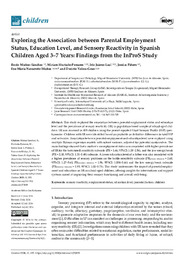Please use this identifier to cite or link to this item:
https://hdl.handle.net/11000/35811Full metadata record
| DC Field | Value | Language |
|---|---|---|
| dc.contributor.author | Muñoz-Sánchez, Rocío | - |
| dc.contributor.author | HURTADO-POMARES, MIRIAM | - |
| dc.contributor.author | Juárez Leal, Iris | - |
| dc.contributor.author | Piñero Peñalver, Jessica | - |
| dc.contributor.author | Navarrete-Muñoz, Eva María | - |
| dc.contributor.author | Valera-Gran, Desirée | - |
| dc.contributor.other | Departamentos de la UMH::Patología y Cirugía | es_ES |
| dc.date.accessioned | 2025-03-05T12:39:20Z | - |
| dc.date.available | 2025-03-05T12:39:20Z | - |
| dc.date.created | 2024-07-14 | - |
| dc.identifier.citation | Children (Basel). 2024 Jul 14;11(7):855 | es_ES |
| dc.identifier.issn | 2227-9067 | - |
| dc.identifier.uri | https://hdl.handle.net/11000/35811 | - |
| dc.description.abstract | Abstract: This study explored the association between parental employment status and education level and the prevalence of sensory reactivity (SR) in population-based sample of school-aged children. SR was assessed in 495 children using the parent-reported Short Sensory Profile (SSP) questionnaire. Children with SR were identified based on probable or definitive differences in total SSP and subscales. Association between parental employment and education level were explored using multiple Poisson regression models with robust variance, adjusted for potential confounders. The main findings showed that a mother’s unemployment status was associated with higher prevalence of SR for the taste/smell sensitivity subscale (PR = 1.66, 95%CI: 1.08–2.56), and the low energy/weak (PR = 2.18, 95%CI: 1.31–3.49) subscale. A lower education level of a father was also associated with a higher prevalence of sensory problems on the tactile sensitivity subscale (PRprimary education = 2.68, 95%CI: 1.27–5.61; PRsecondary education = 1.96, 95%CI: 1.004–3.66) and the low energy/weak subscale (PRsecondary education = 1.95, 95%CI: 1.02–3.73). This study underscores the impact of parental employment and education on SR in school-aged children, offering insights for interventions and support systems aimed at improving their sensory functioning and overall well-being. | es_ES |
| dc.format | application/pdf | es_ES |
| dc.format.extent | 12 | es_ES |
| dc.language.iso | eng | es_ES |
| dc.publisher | MDPI | es_ES |
| dc.rights | info:eu-repo/semantics/openAccess | es_ES |
| dc.rights | Attribution-NonCommercial-NoDerivatives 4.0 Internacional | * |
| dc.rights.uri | http://creativecommons.org/licenses/by-nc-nd/4.0/ | * |
| dc.subject | sensory reactivity | es_ES |
| dc.subject | employment status | es_ES |
| dc.subject | education level | es_ES |
| dc.subject | parental factors | es_ES |
| dc.subject | children | es_ES |
| dc.title | Exploring the Association between Parental Employment Status, Education Level, and Sensory Reactivity in Spanish Children Aged 3–7 Years: Findings from the InProS Study | es_ES |
| dc.type | info:eu-repo/semantics/article | es_ES |
| dc.relation.publisherversion | https://doi.org/10.3390/ children11070855 | es_ES |

View/Open:
2024 - Association between Parental Employment, Education Level, and SR_InProS.pdf
300,43 kB
Adobe PDF
Share:
.png)
